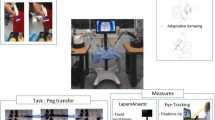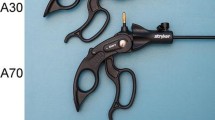Abstract
Purpose
Laparoscopic surgery has improved outcomes in abdominal surgery, but presents kinematic restrictions for surgeons. Robotic comanipulation with adaptative damping has been investigated in simple laparoscopic tasks. The present protocol aimed to determine the contribution of adaptive damping in complex bimanual tasks approaching clinical setting.
Methods
Fourteen residents in general surgery performed three exercises, and for each three repetitions without (classic repetitions) and three with robotic assistance (robotic repetitions) in a randomised order. The exercises chosen were trajectory, modified Pea on a Peg and intracorporeal suture. Task performance, gesture performance, workload and impression were measured. Also, a semi-directed interview was performed to collect the participants’ feeling about companipulated robots and their potential application in clinical practice.
Results
Adaptative damping assistance did not impact task performance, but allowed an economy of movement in the non-dominant hand during suture exercise (distance 916 ± 500 mm in classic vs. 563 ± 261 mm in robotic, p < 0.001). Perceived workload (p = 0.12) and user’s impression were not different between classic and robotic repetitions, except novelty (p < 0.001). Participants’ interviews revealed their interest for the robotic devices, particularly the gravity compensation, and were ready to use the adaptative damping provided an intermittent use, for example to dissect dangerous areas.
Conclusion
Adaptative damping applied by comanipulated robots does not influence the performance of the task, but improves the performance of the gesture itself, particularly for the non-dominant hand, and during the realisation of a complex task like suturing. For residents in digestive surgery, this assistance does increase workload, and they would use this help in the operating room under certain conditions.




Similar content being viewed by others
References
Pucher PH, Mackenzie H, Tucker V, Mercer SJ (2021) A national propensity score-matched analysis of emergency laparoscopic versus open abdominal surgery. Br J Surg 108:934–940. https://doi.org/10.1093/bjs/znab048
Wu S-Y, Ho M-H, Chang H-M, Hsu K-F, Yu J-C, Chan D-C (2021) Long-term oncologic result of laparoscopic versus open gastrectomy for gastric cancer: a propensity score matching analysis. World J Surg Oncol 19:101. https://doi.org/10.1186/s12957-021-02217-2
Crothers IR, Gallagher AG, McClure N, James DT, McGuigan J (1999) Experienced laparoscopic surgeons are automated to the “fulcrum effect”: an ergonomic demonstration. Endoscopy 31:365–369. https://doi.org/10.1055/s-1999-26
Dharia SP, Falcone T (2005) Robotics in reproductive medicine. Fertil Steril 84:1–11. https://doi.org/10.1016/j.fertnstert.2005.02.015
Reitano E, de’Angelis N, Schembari E, Carrà MC, Francone E, Gentilli S, La Greca G (2021) Learning curve for laparoscopic cholecystectomy has not been defined: a systematic review. ANZ J Surg 91:E554–E560. https://doi.org/10.1111/ans.17021
Cuk P, Simonsen RM, Komljen M, Nielsen MF, Helligsø P, Pedersen AK, Mogensen CB, Ellebæk MB (2021) Improved perioperative outcomes and reduced inflammatory stress response in malignant robot-assisted colorectal resections: a retrospective cohort study of 298 patients. World J Surg Oncol 19:155. https://doi.org/10.1186/s12957-021-02263-w
Khan JS, Ahmad A, Odermatt M, Jayne DG, Ahmad NZ, Kandala N, West NP (2021) Robotic complete mesocolic excision with central vascular ligation for right colonic tumours: a propensity score-matching study comparing with standard laparoscopy. BJS Open 5:zrab016. https://doi.org/10.1093/bjsopen/zrab016
Blavier A, Gaudissart Q, Cadière G-B, Nyssen A-S (2007) Perceptual and instrumental impacts of robotic laparoscopy on surgical performance. Surg Endosc 21:1875–1882. https://doi.org/10.1007/s00464-007-9342-5
I Avellino, G Bailly, G Canlorbe, J Belghiti, G Morel, et al Impacts of telemanipulation in robotic assisted surgery. In: Proceedings of the 2019 CHI conference on human factors in computing systems
Troccaz J (2013) Medical robotics. Wiley, Hoboken
Mitchell B, Koo J, Iordachita I, Kazanzides P, Kapoor A, Handa J, Hager G, Taylor R (2007) Development and application of a new steady-hand manipulator for retinal surgery. In: Proceedings 2007 IEEE international conference on robotics and automation. pp 623–629
Dong L, Perrin N, Richer F, Roby-Brami A, Morel G (2022) The stability investigation of variable viscosity control in the human-robot interaction. Int J Med Robot 18:e2416. https://doi.org/10.1002/rcs.2416
Ikeura R, Inooka H (1995) Variable impedance control of a robot for cooperation with a human. In: Proceedings of 1995 IEEE international conference on robotics and automation. pp 3097–3102, vol 3
Nassar A, Vérité F, Pechereau F, Morel G, Vitrani M-A (2023) Adaptative damping assistance in bimanual laparoscopic surgery. Int J Comput Assist Radiol Surg 18:741–751. https://doi.org/10.1007/s11548-022-02796-9
Powers TW, Bentrem DJ, Nagle AP, Toyama MT, Murphy SA, Murayama KM (2005) Hand dominance and performance in a laparoscopic skills curriculum. Surg Endosc 19:673–677. https://doi.org/10.1007/s00464-003-8290-y
Schreuder HWR, van den Berg CB, Hazebroek EJ, Verheijen RHM, Schijven MP (2011) Laparoscopic skills training using inexpensive box trainers: which exercises to choose when constructing a validated training course. BJOG 118:1576–1584. https://doi.org/10.1111/j.1471-0528.2011.03146.x
Ritter EM, Scott DJ (2007) Design of a proficiency-based skills training curriculum for the fundamentals of laparoscopic surgery. Surg Innov 14:107–112. https://doi.org/10.1177/1553350607302329
Montoya-Alvarez S, Minor-Martínez A, Ordorica-Flores RM, Padilla-Sánchez L, Tapia-Jurado J, Pérez-Escamirosa F (2020) Construct validity of the SurgForce system for objective assessment of laparoscopic suturing skills. Surg Endosc 34:5188–5199. https://doi.org/10.1007/s00464-020-07873-1
Soper NJ, Hunter JG (1992) Suturing and knot tying in laparoscopy. Surg Clin North Am 72:1139–1152. https://doi.org/10.1016/s0039-6109(16)45837-8
Borahay MA, Haver MC, Eastham B, Patel PR, Kilic GS (2013) Modular comparison of laparoscopic and robotic simulation platforms in residency training: a randomized trial. J Minim Invasive Gynecol 20:871–879. https://doi.org/10.1016/j.jmig.2013.06.005
Akand M, Altintas E, Kilic O, Gul M, Erdogdu MB Does previous video game experience affect laparoscopic skills? Evaluation of non-medical school students with a novel laparoscopic training box
Derossis AM, Fried GM, Abrahamowicz M, Sigman HH, Barkun JS, Meakins JL (1998) Development of a model for training and evaluation of laparoscopic skills. Am J Surg 175:482–487. https://doi.org/10.1016/s0002-9610(98)00080-4
Fraser SA, Klassen DR, Feldman LS, Ghitulescu GA, Stanbridge D, Fried GM (2003) Evaluating laparoscopic skills: setting the pass/fail score for the MISTELS system. Surg Endosc 17:964–967. https://doi.org/10.1007/s00464-002-8828-4
Marinetto E, García-Mato D, GarcíA A, Martínez S, Desco M, Pascau J (2018) Multicamera optical tracker assessment for computer aided surgery applications. IEEE Access 6:64359–64370. https://doi.org/10.1109/ACCESS.2018.2878323
Oropesa I, Chmarra MK, Sánchez-González P, Lamata P, Rodrigues SP, Enciso S, Sánchez-Margallo FM, Jansen F-W, Dankelman J, Gómez EJ (2013) Relevance of motion-related assessment metrics in laparoscopic surgery. Surg Innov 20:299–312. https://doi.org/10.1177/1553350612459808
Hart SG (2006) Nasa-task load index (NASA-TLX); 20 years later. Proc Hum Factors Ergon Soc Annu Meet 50:904–908. https://doi.org/10.1177/154193120605000909
Schrepp M, Hinderks A, Thomaschewski J (2014) Applying the user experience questionnaire (UEQ) in different evaluation scenarios. In: Marcus A (ed) Design, user experience, and usability. Theories, methods, and tools for designing the user experience. Springer, Cham, pp 383–392
Tsumugiwa T, Yokogawa R, Hara K (2002) Variable impedance control based on estimation of human arm stiffness for human-robot cooperative calligraphic task. In: Proceedings 2002 IEEE international conference on robotics and automation (Cat. No.02CH37292). pp 644–650, vol 1
Nieboer TE, Sari V, Kluivers KB, Weinans MJN, Vierhout ME, Stegeman DF (2012) A randomized trial of training the non-dominant upper extremity to enhance laparoscopic performance. Minim Invasive Ther Allied Technol 21:259–264. https://doi.org/10.3109/13645706.2011.614256
Sutter C, Sülzenbrück S, Rieger M, Müsseler J (2013) Limitations of distal effect anticipation when using tools. New Ideas Psychol 31:247–257. https://doi.org/10.1016/j.newideapsych.2012.12.001
Flash T, Hogan N (1985) The coordination of arm movements: an experimentally confirmed mathematical model. J Neurosci 5:1688–1703. https://doi.org/10.1523/JNEUROSCI.05-07-01688.1985
Erden MS, Marić B (2011) Assisting manual welding with robot. Robot Comput-Integr Manuf 27:818–828. https://doi.org/10.1016/j.rcim.2011.01.003
Ruurda JP, Visser PL, Broeders IAMJ (2003) Analysis of procedure time in robot-assisted surgery: comparative study in laparoscopic cholecystectomy. Comput Aided Surg 8:24–29. https://doi.org/10.3109/10929080309146099
Funding
No funding was received to assist with the preparation of this manuscript.
Author information
Authors and Affiliations
Contributions
All authors contributed to the study conception and design. Material preparation, data collection and analysis were performed by AN, FP and FV. The first draft of the manuscript was written by AN, and all authors commented on previous versions of the manuscript. All authors read and approved the final manuscript.
Corresponding author
Ethics declarations
Conflict of interest
The authors have no competing interests to declare that are relevant to the content of this article.
Informed consent
Informed consent was obtained from all individual participants included in the study.
Additional information
Publisher's Note
Springer Nature remains neutral with regard to jurisdictional claims in published maps and institutional affiliations.
Rights and permissions
Springer Nature or its licensor (e.g. a society or other partner) holds exclusive rights to this article under a publishing agreement with the author(s) or other rightsholder(s); author self-archiving of the accepted manuscript version of this article is solely governed by the terms of such publishing agreement and applicable law.
About this article
Cite this article
Nassar, A., Vérité, F., Pechereau, F. et al. Assistance by adaptative damping on a complex bimanual task in laparoscopic surgery. Int J CARS (2024). https://doi.org/10.1007/s11548-024-03082-6
Received:
Accepted:
Published:
DOI: https://doi.org/10.1007/s11548-024-03082-6




